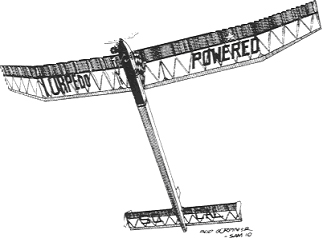|
Class A-B Nostalgia Gas Lucky Lindy FAI
Updated August 11, 2003
Brief recommendations from Bob Beecroft's highly successful FAI version of Larry Conover's 1956 World Championship Co-Winning model, campaigned 1990 to date.
Engine offsets: 3° 0' Left thrust
2° 45' Down thrust.
Certainly better to build these in to start, rather than the cobby way shown on the '58 AM plan. No side thrust shown on those plans, but the 3° Left sure makes it VTO straight.
Stab: Flat & 90° to fuse CL . Tilt - 7/16" difference left to right, right side high for right glide.* Less tilt better for more calm air duration / big fields. Keep it light!
*(I'm using a quarter inch now; big circles)
Wing: Center section: Flat
Left main panel: Flat Right main: 7/32-1/4" Wash-in*
Left tip: 1/8" Wash-out Right tip: 1/16" Wash-out
*Additionally, recommend aileron trim tab on the wing main panel as shown: screw-adjusting a great idea. See note under Fin Offsets regarding mounting.
Fuselage: As per JOR plan outline. Sides, top and bottom - I recommend splicing the lengths using long scarf joints. Use nice firm wood to the rear of the pylon area, nice light wood for the tail boom. I use a piece of 6000 strand carbon fiber tow CA'd in place top and bottom of each fuselage side. I do this by placing the CF down straight, using thin CA a drop or two at a time onto it. Watch it wick in and along a length, then quickly cover with waxed paper and rub it down hard. Then do the next length till it reaches the end. I double it up at nose, running a second 6000 strand piece at the top and bottom of the fuse sides to about 3" past the rear of the pylon. About a 6" piece overlaps the stab LE area, lapping about 3" either side of the stab platform top and bottom again. Once this is done, the fuselage is built in the normal box body manner.
Additionally, I like to use about 3 layers of 3-ounce glass S-cloth around the nose. One a couple of inches back from the firewall, the second to about the mid-point of the pylon, and the third to a point a couple of inches past the pylon. Make that fuselage straight! That CF on the inside makes that old box of balsa really really strong, and the reinforced front end will last through years and years of handling!!
CG: As per JOR plan. The more rearward position shown (5½") for high power engines (GH .19-.23) per Conover's original plan. My experience with a very hot Veco .19: the CG at 5¼" behind the LE seems to work well. Trimmed for a larger glide circle, the CG will need to move a bit¦keep the tail light. Move the pylon to achieve the initial CG, leaving it just a little nose heavy to allow for dings and repairs that come along¦ most always behind the CG! Mine has the front of the pylon shoved forward to 1¼" behind the firewall¦with a bit of lead in the tail. Better to have to add here than anywhere else¦easy to take out to make minor glide trim adjustments.
Fin offsets: Make every effort to see that everything is dead-straight (or at 90° to the fuse CL like the wing and stab). Use an engineer's square to ensure the tip fins are really 90° to the stab span. Mine flys with the tiny tab as shown on the JOR plan. It is either dead-straight or with a tiny bit of right screwed in (1/32 is a lot). For Cat III's short motor runs and fly-off's, the tab goes a bit right to get a better transition from slower speeds attained. Longer runs, use less tab and a straighter climb where there is sufficient speed to go over the top to recover. The tab is sensitive, like Conover notes. I use a 1-72 screw on a post for adjustments. Try mounting the tab using .020 music wire acting as both hinge and a torsion bar for spring tension on the tab. Works great.
Incidence: As per JOR plan, both wing and tail. Leave a little room under the stab TE for positive incidence adjustments a 1/32" or so. There is a coincident small amount of positive stab incidence that needs to be cranked in as the power goes up and the CG moves back. DT hammer with screw-adjustment highly recommended. Mechanical or electronic timer activated is wonderful improvement.
Dihedral: As per the JOR plan.
Please feel free to call, write or e-mail me with comments, suggestions or corrections.
Bob Beecroft
3488 Linda Vista Terrace
Fallbrook, CA 92028-9127
TheAeroSmith@adelphia.net
760-723-2499
|






